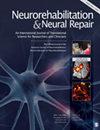Measurement of Cerebral Glucose Metabolism in the Visual Cortex Predicts the Prognosis of Hemianopia.
IF 3.7
2区 医学
Q1 CLINICAL NEUROLOGY
引用次数: 0
Abstract
BACKGROUND AND OBJECTIVE Homonymous hemianopia caused by cerebrovascular disease may improve over time. This study investigated whether functional neuroimaging can predict the prognosis of hemianopia due to cerebral infarction. METHODS We studied 19 patients (10 men and 9 women) with homonymous hemianopia and compared them with 34 healthy subjects (20 men and 14 women). Cerebral glucose metabolism was measured by 18F-fluorodeoxyglucose positron emission tomography (FDG-PET), 1 to 6 months after the onset. Bilateral regions of interest (ROIs) were selected from the posterior and, anterior striate cortices, extrastriate cortex, and thalamus. Furthermore, semi-quantitative data on cerebral glucose metabolism were obtained for ROIs and compared with the data obtained for homologous regions in the contralateral hemisphere by calculating the ipsilateral/contralateral (I/C) ratio. RESULTS The I/C ratio for the cerebral glucose metabolism in the posterior striate cortex was high (>0.750) in 8 patients, and the central visual field of these patients improved or showed macular sparing. The I/C ratio for cerebral glucose metabolism in the anterior striate cortex was high (>0.830) in 7 patients, and the peripheral visual field of these patients improved. However, no improvement was observed in 9 patients with a low I/C ratio for cerebral glucose metabolism in both the posterior and anterior striate cortices. CONCLUSION Measurement of cerebral glucose metabolism in the striate cortex is useful for estimating visual field prognosis. Furthermore, FDG-PET is useful in predicting the prognosis of hemianopia.测量视觉皮层的脑葡萄糖代谢可预测半身不遂的预后
背景和目的由脑血管疾病引起的同向偏盲可能会随着时间的推移而改善。本研究探讨了功能性神经影像学能否预测脑梗塞所致半身不遂的预后。方法 我们研究了 19 名同名半身不遂患者(10 名男性和 9 名女性),并将他们与 34 名健康受试者(20 名男性和 14 名女性)进行了比较。在发病 1 至 6 个月后,通过 18F-氟脱氧葡萄糖正电子发射断层扫描(FDG-PET)测量脑葡萄糖代谢。双侧感兴趣区(ROI)选自后部和前部纹状皮层、纹外皮层和丘脑。结果8名患者后纹状体皮层脑葡萄糖代谢的I/C比值较高(>0.750),这些患者的中心视野有所改善或出现黄斑疏松。7 名患者前纹状体皮层脑糖代谢的 I/C 比值较高(>0.830),这些患者的周边视野有所改善。结论 测量纹状皮层的脑糖代谢有助于估计视野预后。此外,FDG-PET 还有助于预测偏盲的预后。
本文章由计算机程序翻译,如有差异,请以英文原文为准。
求助全文
约1分钟内获得全文
求助全文
来源期刊
CiteScore
8.30
自引率
4.80%
发文量
52
审稿时长
6-12 weeks
期刊介绍:
Neurorehabilitation & Neural Repair (NNR) offers innovative and reliable reports relevant to functional recovery from neural injury and long term neurologic care. The journal''s unique focus is evidence-based basic and clinical practice and research. NNR deals with the management and fundamental mechanisms of functional recovery from conditions such as stroke, multiple sclerosis, Alzheimer''s disease, brain and spinal cord injuries, and peripheral nerve injuries.

 求助内容:
求助内容: 应助结果提醒方式:
应助结果提醒方式:


